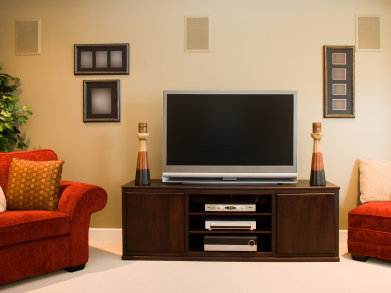One of my college roommates just moved into a new house, which we believe to be his 25th different residence since graduation. He's spent time in at least six different states and an array of apartments, condominiums and houses since picking up his diploma.
Every time he gives me a new home address and an invitation to visit, I marvel at his nomadic lifestyle and he simply shrugs.
"As long as I have a decent rack (bed) and a really good flat screen (TV), I can live anywhere and be happy," he said, laughing. "Those are my basic necessities."
I thought about him last month, when I was wandering the aisles at the electronics store in search of a new TV for my rec room. He may be crazy, but he's not wrong. Other than the refrigerator and certain fixtures in the bathroom, what gets more use in your home than the bed and the TV set?
A lot of people purchase those key items -- or receive them as hand-me-downs -- without giving them much thought. We can address the mattress issue at a later date. Today, however, we take up the topic of the flat screen TV.
There are plenty of folks out there who salivate over the latest technology and scour specialty magazines and Web sites in search of tidbits about black levels, color saturation, "blooming" and other terms that prompt the eyeballs of normal consumers to glaze over.
If you are in that camp, you may as well stop reading now.
This is a primer for folks whose concern about TV sets pretty much stops once they turn on the remote. Buying a new TV can be an overwhelming and somewhat intimidating experience. It can also be expensive. If you have the need / desire to get a new TV, here are a few tips to get your search started.
Size matters: You have to decide how much TV you need, remembering that the size of the screen is measured diagonally.
It may seem like common sense, but a lot of people don't consider the size and configuration of the room where they will be watching the new set. If you're going to mount it on a wall, it might help to know that a 50-inch TV -- even if it's a great deal -- won't fit the available space.
A key thing to remember is that bigger isn't always better. If your couch is four feet from the entertainment center, you might not enjoy a 60-inch plasma as much as you would a 32- or even a 37-incher.
There are no hard-and-fast formulas, but a good rule of thumb is to take the screen size and multiply by two. That's how many inches you should be sitting from the screen for optimum viewing. For example, a 50-inch TV would give you 100 inches, or just less than 8 1/2 feet.
Generally speaking, mid-sized TVs of about 32 inches are fine for bedrooms. If you are going to be watching from eight or nine feet, a 42-inch set will be fine. If your viewing distance is 10 or 12 feet or more, you can get that 60-incher.
The viewing environment: If you're going to buy a flat screen work of art, you might want to consider displaying it on something other than a card table or empty beer cases. If you need to buy a cool table, wall mount or entertainment center, be sure and price those so you can adjust your TV budget.
LCD vs. Plasma: This is another basic question. Both formats have their advantages and disadvantages. Experts will tell you that LCD screens are better for rooms with a lot of natural light. Plasmas work better in darker rooms. Some say that plasma screens offer better picture quality, particularly from better angles, but LCD sets are closing the gap. Plasma screens generally run larger, so if you have a smaller room your best bet may be an LCD.
Brands: There are many brands out there and most of the better-known offerings -- Sony, Samsung, Panasonic, Pioneer, Sharp, Toshiba, JVC, LG, Phillips and Vizio -- offer terrific sets. There are "off" brands that can be good bargains and provide good quality, but the safer play is one of the bigger manufacturers.
Resolution: HDTVs come with one of three resolution capabilities: 720p, 1080i and 1080p. The "p" stands for progressive scan and the "i" stands for interlaced. The best of the three is 1080p, because that means the set can show full-HD content at 1,920 x 1,080 pixels.
1080i sets offer an interlaced version of the same display, with odd-numbered and even-numbered lines appearing alternatively. The 720p sets are fine for most content, but discerning viewers will notice a slight difference in picture quality. Some manufacturers are scaling back on 720p sets, but they can be purchased at bargain rates.
How important is all this to you? Will you be watching a lot of Blu-ray DVDs with tech geeks? Or, will you be watching Packers games alone? Will you playing a lot of video games?
Connection Ports
Sound: Many HDTV consumers will purchase external receiver/speaker systems to enhance the audio. HDMI is the standard for connecting a PS3 or Blu-ray player. If you aren't upgrading the audio part of things, make sure a new set will be compatible with your existing equipment.
Looks can deceive: When you look at a line of sets in a store playing the same channel or DVD, you may notice that some sets appear brighter. You should remember, though, that the settings may be tweaked differently. Also realize that the bright lights in those stores may alter your impression of the TV and the huge surroundings can throw off your sense of size.
Budget: Let's face it, this is probably the most important part of the decision. Prices vary between big box retailers and online outlets, but you can generally get a good 32-inch LCD for between $300 and $500. If you want a 42-inch screen, you can spend $500 to $800 for a solid model. Plasmas of 47 to 50 inches can run between $800 and $1,100 or so.
Host of “The Drew Olson Show,” which airs 1-3 p.m. weekdays on The Big 902. Sidekick on “The Mike Heller Show,” airing weekdays on The Big 920 and a statewide network including stations in Madison, Appleton and Wausau. Co-author of Bill Schroeder’s “If These Walls Could Talk: Milwaukee Brewers” on Triumph Books. Co-host of “Big 12 Sports Saturday,” which airs Saturdays during football season on WISN-12. Former senior editor at OnMilwaukee.com. Former reporter at the Milwaukee Journal Sentinel.



.jpeg)



